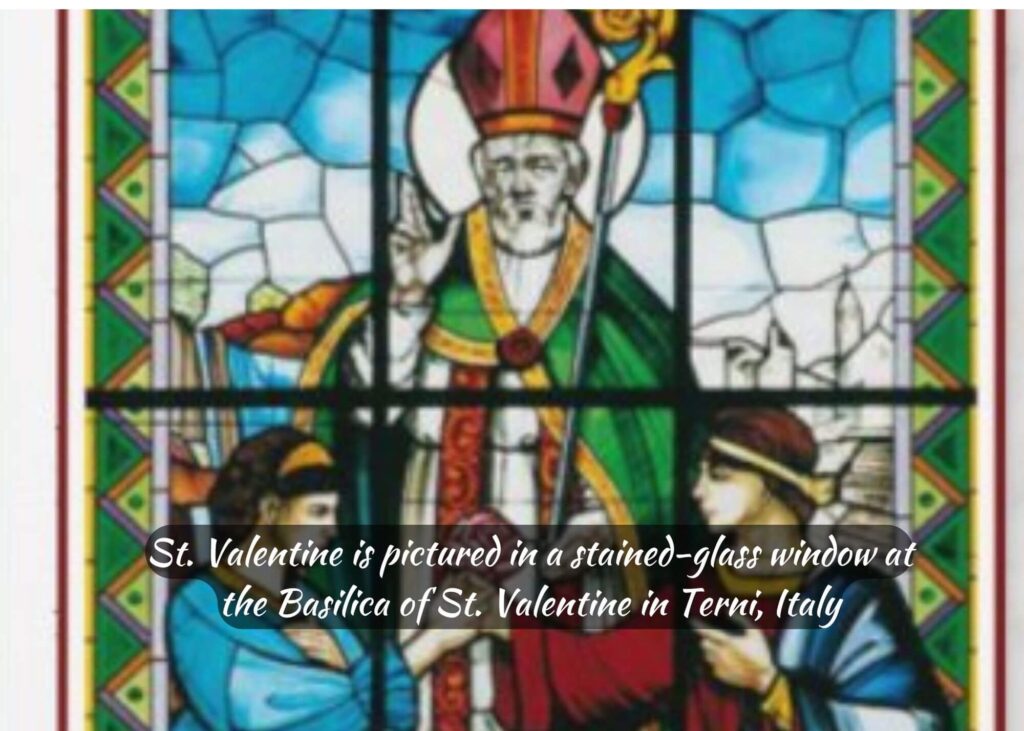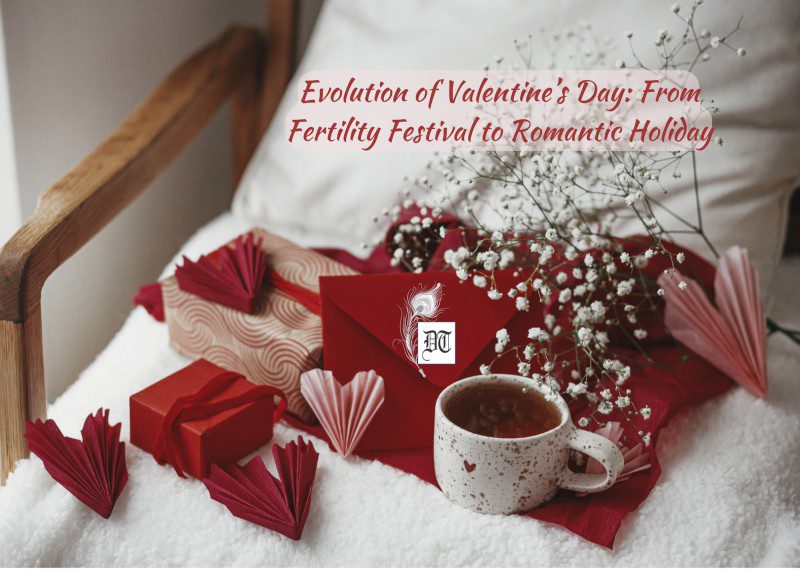Valentine’s Day’s origins can be traced back to centuries of fertility rites, but today it’s primarily about romance. Arindam traces the folklore, from secret weddings to Chaucer’s lovebirds, in a Special Feature, exclusively for Different Truths.

Valentine’s Day, traditionally known as a day of love and romance, has a somewhat bloody origin that dates back centuries. The holiday’s commercialisation can be traced to a combination of historical events, cultural influences, and marketing strategies.
The origins of Valentine’s Day can be traced back to ancient Rome, where it was initially observed as a pagan fertility festival called Lupercalia, celebrated from February 13th to 15th. During this festival, young men would sacrifice animals and then whip women with the hides of the animals they had just slain. It was believed that this ritual promoted fertility and purification.
The transition from Lupercalia to Valentine’s Day as we know it today began in the early Christian era.
The transition from Lupercalia to Valentine’s Day as we know it today began in the early Christian era. The Catholic Church sought to Christianise pagan festivals, and in the 5th century, Pope Gelasius I declared February 14th as St. Valentine’s Day to honour the martyrdom of St. Valentine, a Roman priest who was executed on that day in AD 269 or 270.
The story of St. Valentine is shrouded in legend, with several conflicting accounts of his life and martyrdom. One popular legend suggests that St. Valentine performed secret marriages for Roman soldiers, defying Emperor Claudius II’s decree banning marriage for young men because he believed that single men made better soldiers. Another legend suggests that St. Valentine helped Christians escape harsh Roman prisons, where they were often subjected to torture and persecution. Regardless of the specifics, St. Valentine’s Day became associated with love and romance due to these stories of forbidden love and sacrifice.
The association of Valentine’s Day with romantic love grew over time…
The association of Valentine Day’s romantic love grew over time, particularly during the Middle Ages, when courtly love flourished in European literature. Geoffrey Chaucer, in his poem “Parliament of Foules,” written in the 14th century, linked Valentine’s Day with romantic love by describing birds choosing their mates on that day.
The commercialisation of Valentine’s Day began to take shape in the 19th century with the rise of the printing press and the mass production of Valentine’s Day cards. Printing businesses that mass-produced cards with romantic messages and intricate designs helped to promote the practice as it became more and more common to exchange handmade cards and love notes.
In the United States, Esther A. Howland, known as the “Mother of the Valentine,” began selling the first mass-produced valentines in the 1840s. Her elaborate, handcrafted cards adorned with lace, ribbons, and colourful illustrations became immensely popular, contributing to the commercialisation of Valentine’s Day.
Valentine’s Day is one of the most commercially successful holidays, with billions of dollars spent on gifts…
Throughout the 20th century, marketing campaigns by retailers and advertisers helped to fuel the trend of exchanging gifts and tokens of affection on Valentine’s Day. Today, Valentine’s Day is one of the most commercially successful holidays, with billions of dollars spent on gifts such as flowers, chocolates, greeting cards, jewellery, and romantic dinners.
In conclusion, while Valentine’s Day may have originated as a bloody reminder of the execution of St. Valentine and evolved from a pagan fertility festival, its commercialisation can be attributed to a combination of historical, cultural, and economic factors. From its humble beginnings, as handwritten love notes to the elaborate commercial holiday it is today, Valentine’s Day continues to be celebrated worldwide as a day of love, romance, and commercial indulgence.
References:
1. History.com Editors. (2009, November 9). Valentine’s Day. History. https://www.history.com/topics/valentines-day/history-of-valentines-day
2. Kruse, C. (2014, February 14). Esther A. Howland: “The Mother of the American Valentine.” New England Historical Society. https://www.newenglandhistoricalsociety.com/esther-a-howland-mother-american-valentine/
3. Strong, J. (2019, February 13). Valentine’s Day: How a pagan festival became a global celebration of love. The Conversation. https://theconversation.com/valentines-day-how-a-pagan-festival-became-a-global-celebration-of-love-111319
Author’s Note: Arindam is grateful for the factual input from Anumita Roy that helped him pen this article.

Love & Miracle: Unravelling the Blind Girl Legend of St. Valentine
The legend of St. Valentine’s love for a blind girl is one of the many stories associated with the revered saint and his compassionate acts. While there are various versions of this tale, they all share a common theme of St. Valentine’s kindness and miraculous healing.
According to one version of the story, during the time of Emperor Claudius II’s reign in Rome, St. Valentine, a Christian priest, was known for his dedication to helping Christians persecuted by the Roman Empire. Despite the emperor’s decree banning marriages for young men, St. Valentine secretly performed Christian marriages.
During his imprisonment for defying the emperor’s orders, St. Valentine encountered the jailer’s blind daughter, who was said to have been named Julia or Asterius’ daughter in some versions of the legend. Moved by compassion, St. Valentine befriended the young girl and began to teach her about Christianity.
As their friendship deepened, the blind girl expressed her desire to see the world and witness its beauty. Touched by her wish, St. Valentine prayed fervently for her healing. Miraculously, the girl’s sight was restored, and she could see the world for the first time.
Grateful for her miraculous healing and touched by St. Valentine’s kindness, the girl developed romantic feelings for the saint. In some versions of the story, St. Valentine also reciprocated her feelings, and they fell in love.
Unfortunately, their love story faced a tragic end when St. Valentine was martyred for his Christian faith on February 14th, around 269 AD. Before his execution, it is said that St. Valentine left a note for the young girl, signed “From your Valentine,” which is believed to be the origin of the tradition of sending Valentine’s Day cards.
While the historical accuracy of this legend is uncertain, it has become deeply ingrained in the folklore surrounding St. Valentine and Valentine’s Day. The story exemplifies themes of love, compassion, and sacrifice, which have contributed to the enduring popularity of St. Valentine as a symbol of romantic love and devotion.
References:
1. Butler, A. (1866). The Lives of the Fathers, Martyrs, and Other Principal Saints: Volume II. D. & J. Sadlier & Company.
2. Harris, P. (2013). A Heartbeat Away: A True Story of Tragedy and Triumph. Destiny Image Publishers.
3. Hoobler, D. S., & Hoobler, T. (2011). The St. Valentine’s Day Massacre: The Untold Story of the Gangland Bloodbath That Brought Down Al Capone. Skyhorse Publishing, Inc.
4. Marshall, R. (1993). The Story of Saint Valentine. Carolrhoda Books.
5. Shoemaker, A. (2017). Saint Valentine. Bloomsbury Publishing.
6. Tabor, M. J. (2012). The Jesus Dynasty: The Hidden History of Jesus, His Royal Family, and the Birth of Christianity. Simon and Schuster.
Picture design by Anumita Roy





 By
By
 By
By
 By
By
Thank you for dusting the hype without spoiling it for us!!
Azam ji, thanks a lot for your critique. Means a lot.